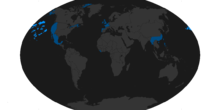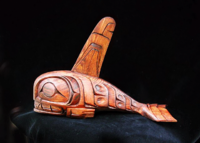Nation/Adainia
| This page is considered a work in progress by the ADE Board of Government Education, and should not be considered final. Information may be missing or inaccurate during this process. |
| Information on this page is considered public information by the ADE Board of Government Education. It may be used by the general public without explicit permission given by the Adainian government. | |
| This article is hosted on ADE BoGE Database 1 in the FFD. Last updated: June 29th, 2021 |
| United States of Adainia | |||||
|---|---|---|---|---|---|
|
|||||
| Motto: "Por libreco, por teknologio, por prospero" "For liberty, for technology, for prosperity" |
|||||
| Anthem: "Adainia the Beautiful" March: "The Adainian Order" |
|||||
The Adainian archipelago, plus overseas territories |
|||||
| Capital | Foxborough Federal District | ||||
| Largest city | San Narciso Largest overseas city: Shanghai, SB | ||||
| Official languages | English, Esperanto | ||||
| Recognised national languages | English, Chinese, Spanish | ||||
| Demonym | Adainian | ||||
| Government | Federal presidential constitutional republic | ||||
| - | President | David Roberts | |||
| - | Vice President | John Ford | |||
| - | President of the House | Ben Shaw | |||
| - | Chief Justice | Joseph Woods | |||
| Legislature | Congress | ||||
| - | Upper house | Senate | |||
| - | Lower house | Representatives | |||
| Formation | |||||
| - | First modern settlement | ~February, 1947 | |||
| - | Recognition by the United States of America | November 5th, 1955 | |||
| - | Ratification of La Leĝoj de la Personoj | December 1st, 1955 | |||
| Area | |||||
| - | Total land area Disregards overseas territories | 463,260 km2 287,856 sq mi |
|||
| Population | |||||
| - | National estimate | 3.021 Billion | |||
| - | 2020 Archipelago census | 107,943,102 | |||
| GDP (PPP) | 2020 estimate | ||||
| - | Total | 117.763 Trillion NA$ | |||
| - | Per capita | 38,981.38 NA$ | |||
| Currency | North American Dollar (NAD) |
||||
| Time zone | (UTC-12 to UTC+12) | ||||
| - | Summer (DST) | not observed (UTC-12 to UTC+12) |
|||
| All Adainian timezones are permanently set to Summer time | |||||
| Date format | YYYY-MM-DD | ||||
| Drives on the | right | ||||
| Calling code | +1 | ||||
| ISO 3166 code | AD | ||||
| Internet TLD | .ad .gov .mil .edu | ||||
The United States of Adainia (USA), commonly referred to as Adainia, the United States, or The-New-Empire-Where-The-Sun-Never-Sets, is a federal republic composed of six states, two federally controlled sectors, the Foxborough Federal District, eight major semi-autonomous territories, and various possessions. The six states, two federal sectors, and the FFD are in the eastern Pacific Ocean west of the North American continent. The eight major semi-autonomous territories are around the world. Gold-Coast, Laurentia, Ellesmere, and Aleutia are in the North American continent. Kingsland encompasses the British Isles, Portugal, the Netherlands, Belgium, Luxembourg, southwestern Germany, and the northwestern coasts of Spain and France. Adainian Liberia is on the West African coast. The Sino-Belt consists of what was southern China and most of Burma. Luzon consist of the northern Philippines, specifically Luzon and most of its associated islands. Adainia's smaller possessions and colonies are situated around the world and in parts of the solar system. Viking, a research colony on Jupiter's moon Europa, is the furthest out Adainian possession with people. When including territories, Adainia is approximately 4,209,469 km² and possesses a population of over 3.021 billion people. It is the world's most ethnically diverse and multicultural nation, the product of large-scale immigration and the possession of territories around the world. It is also the world's most geographically and environmentally diverse nation, home to a vast variety of wildlife.
Paleo-Indians migrated from the North American mainland onto the Adainian archipelago at least 15,000 years ago, when the archipelago was primarily one island. Around 10 AD, the archipelago experienced an extreme seismic event which caused it to be submerged until approximately 1300 AD. It remained largely unsettled until around 1680 AD, when the archipelago was colonized by the Chinese. The Chinese within the archipelago, whether through distance or general indifference, were able to declare independence without conflict through the leadership of Emperor Zhou, beginning the reign of the Zhou-Ling Empire. The Zhou-Ling Empire maintained a strict isolationist doctrine, with no one entering or leaving the kingdom. The Spanish Empire discovered both the Adainian archipelago and the Zhou-Ling around 1782 during the establishment of Californian missions. A short, relatively undocumented conflict lasted for two years starting from the discovery of the Zhou-Ling. The Spanish were defeated, and the Zhou-Ling remained independent and isolationist. During American expansion to the west, the Zhou-Ling were once again discovered around 1867. After failed attempts at diplomacy, the United States declared war on the Zhou-Ling and fought from 1867 to 1869 – when the archipelago once again experienced a seismic event which caused its submersion.
In January, 1947, the Adainian archipelago once again resurfaced into the form it possesses today. The American government launched a federal expedition, lead by Thomas Adams, to explore and map the archipelago. However, a series of unfortunate events lead to the death of a majority of the expedition's crew from 200 to 41. Despite much hardship, Thomas Adams was able to lead his expedition to survive within their harsh environment. Adams and his expedition constructed a settlement along the coasts on the same island as the old Zhou-Ling capital, which would eventually become known as Foxborough. Eight years later, Adams was finally able to establish communication between his expedition and America. Although US president Dwight D. Eisenhower initially planned to integrate the archipelago into America as states, Thomas Adams convinced the president to allow the archipelago to become its own nation.
Although the young nation initially struggled, it became successfully independent of international help by 1959. The nation soared from poverty and a weak economy by radical policies by president Jacob Richards and industrial tycoon Richard Madison; policies that followed the Nordic Model. These changes were successful in employing the nation, ascending the lower class into middle and higher class positions, and solidifying/energizing the economy. By 1963, Adainia was spearheading what became known as The Silicon Revolution – a revolution on technology based primarily in Adainia. On November 1st, 1967, Adainia became the first nation to land astronauts on the Moon. It was by this point that Adainia had been officially classified as a global superpower. In 2006, then president Nathan Saunders predicted that the world was in approaching a recession if action was not taken. Thanks to preparation for such an event, Adainia was only affected by a minuscule extent by the 2008 recession. This gave the nation additional time to solidify its power over the world. It began expansion outside of Earth, and became the first nation to colonize another world. During the War of 2020, Adainia saw a massive influx of expansion around Earth. Following its end, Adainia became the world's sole superpower amongst ten other powers and the rest of the world's nations. Adainia is the world's leader in military, economy, and technology.
Adainia is the first nation on Earth to have discovered the existence of rifts, the multiverse, and the various multiversal governing bodies that exist. It maintains control over the world's only rift in the Pacific ocean, and although other nations have since been allowed civil access to it, it remains the only nation in the world with government access. Adainia is an observer and light participant of the multiverse World Assembly. Adainia is currently not involved in multiversal alliances or conflicts, although it maintains civil and military forces capable of relations outside of the universe.
Etymology
The first documented predecessor to the term "Adainia" to refer to the Adainian archipelago dates back to 1782 in a map from the Spanish Empire of territorial claims in the west of the North American continent. Within the map, a landmass off the coast of the continent hypothesized to be the Adainian archipelago is referred to as "Las Islas del Adenas". Adenas refers to Spanish explorer Captain Rio Adenas – a naval captain particularly famous for his coastal expeditions along the west coast of North America. Some time between 1782 and 1791, the name "Las Islas del Adenas" was shortened to "Adeña", a predecessor that nearly matches the pronunciation and spelling of its modern counterpart. The first documented use of "Adeña" was within a letter from Fermín Lasuén, president of the California mission system, to Charles IV of Spain. The section using the term roughly translates to the following:
“To be honest, your majesty, our task has proven to become more difficult than initially thought to be. The Indians from Francisco to the North, Baja to the South, Alcalá to the East, and Adeña to the West. They are all proving to be slow in acknowledging the Lord's blessings.”
The first documented use of its English counterpart, "Adainia", is found in a San Francisco newspaper from 1866 documenting the Spanish history with encounters from the Zhou-Ling. Its spelling, however, remains controversial. Within the San Francisco Chronicle's article at the time, it is referred to as "Adainia". However, one of the newspaper's original owners – Charles de Young – claimed that it was originally meant to be spelled as "Adania" – its normal spelling, omitting the first "i". The San Francisco Chronicle is indeed documented to switch around the spellings from 1866 to 1869.
When Thomas Adams established the nation, however, "Adainia" was the version used in all documentations – including La Leĝoj. Since La Leĝoj's initial signing, "Adainia" has been the root word used for both the nation and related objects of interests.
History
Adainia is a nation with a rich and cultured history dating back to millennia ago. It is primarily separated into two sections: Pre-Establishment and Post-Establishment. Pre-Establishment history encompasses all history related to the archipelago before the establishment of the modern nation. Post-Establishment history covers what is more often considered "Adainian history" — history of the nation itself. Although Pre-Establishment history covers much more time, Post-Establishment history is much more detailed and accurate.
Pre-Establishment History
The Indigenous Peoples and the First Submersion
Humans initially settled in the Adainian archipelago in approximately 13,000 BC during the migration of Paleo-Indians into the Americas. Between 13,000 BC and 12,750 BC was a period of migration into the Adainian archipelago – which at this point mainly consisted of one giant island and a few smaller ones. After this period of migration, travel to and from the archipelago largely ceased for unknown reasons. This lack of travel left the indigenous people to develop a culture independent of those on the North American continent. This initial group of indigenous persons organized into the Kesuks. Although the Kesuks did not develop large marvels of architecture like the Mayans or Aztecs, the Kesuks developed a rich culture and life based on the sea. They became skillful at ship-making and hunting in the ocean. The Kesuks largely settled on the coastlines of the archipelago, and the elders and priests would live in large boathouses.
Despite the relatively simple lifestyle, the Kesuk developed a detailed culture and writing system by 9000 BC. It was around this time that an important insight into Kesuk culture and spirituality was written: Sangilak and Iluak. The Kesuk religion was polytheistic, with gods based on animals of the sea. The two primary gods within the Kesuk religion, Sangilak and Iluak, represented the opposing characteristics of chaos and tranquility. Sangilak and Iluak acted as a spiritual duality within the lives of the Kesuks. For example, as translated from Sangilak and Iluak:
“A hunter cannot hunt with Sangilak without nurture with Iluak. A gatherer cannot take with Sangilak without growth with Iluak. And more importantly, a man cannot punish with Sangilak without love with Iluak.”
Whether it was through these beliefs directly or through working with them, this call for duality lead to the Kesuks living in what has been considered to have been the most balanced and progressive society of the time period. By 7000 BC, men and women had attained an equal balance in membership between roles in the Kesuks, including leadership.
Although isolated from the North American continent, the Kesuks maintained a stable and strong ruling over the archipelago from their initial arrival to their end. Despite efforts to search for evidence pointing towards different tribes or civil conflicts, none have been found. The Kesuks peaked around 100 BC, with a total estimated population of five million. However, the Adainian archipelago experienced a major seismic event around 10 AD that resulted in the first submersion. Although the Kesuks had been almost annihilated, evidence shows that as many as 100 Kesuk tribespeople of various social classes managed to survive and escape to the North American mainland. This has been supported through the excavation of Kesuk artifacts in the Gold Coast and the New Canadian Federation and the similarities between Kesuk culture and tribespeople of the Northwestern North American coast.
The Intersettlement Period and the Zhou-Ling Dynasty
The Adainian archipelago remain submerged from approximately 10 AD until 1300 AD, when it resurfaced more closely like its current form today. Although tribes had attempted to settle on the land, settling proved to be difficult. Animals and plants that had been brought over to the land formed the foundation for the archipelago's ecosystem for its first resurfacing. Despite its light settlement, tribes mainly preferred to stay away from the lands that had been deemed taboo. Through hundreds of years and the work of the few people that chose to settle on the islands, the archipelago had an established ecosystem that primarily consisted of plains and light forests.
Around 1670, work began within the Qing dynasty to colonize westward. Zhou Ling, an experienced naval captain, was selected to become the expedition's leader. Excavated scrolls have been translated show Emperor Kangxi, the emperor of the Qing dynasty at the time, saying the following on the reasoning behind exploring westward:
“ ... it is Heaven's mandate that we explore the new lands that were bestowed upon us. Our great explorers have embarked on endeavors to the east with much fruition. However, little to no progress towards this everlasting goal of expanding our knowledge of the land has been made to the west. It is time that we change this, which is why I send Zhou Ling and his crew westward to further investigate what lies beyond.”
Zhou Ling's expedition began on August 18th, 1680, and lasted for approximately one month. Unlike Columbus's expedition in Europe, Zhou Ling knew and acknowledged that the expedition had the potential of lasting much longer. With a surplus of food and supplies, the trip to Adainia was nothing short of a complete success. Zhou Ling's initial expedition stayed in the Adainian archipelago for two months. Within these two months, Zhou Ling established his first settlement in the archipelago: 福克斯巢穴, or Fox Lair. The natives, already in minimum numbers at this point, were also murdered by Zhou Ling and his crew. Contending with firearms and an overall superior force, the remaining natives were killed off easily according to records.






